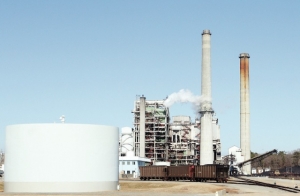Timetable in place for demolition of former H.F. Lee Power Plant
By Steve Herring
Published in News on December 5, 2013 1:46 PM

The H.F. Lee Power Plant
The smokestacks that have towered over the Wayne County countryside for more than 60 years will soon be gone -- and by mid-2015 what had been the old H.F. Lee Power Plant will be just a memory.
Progress Energy Carolinas retired the plant's three coal units -- built in 1951, 1952 and 1962 -- and the four oil-fueled combustion turbines in the fall of 2012. Progress Energy has since merged with Duke Energy.
Duke Energy's long-range plans for its sites with retired coal units such as Lee is to safely return them to ground level using a method known as decommissioning and demolition.
The multi-year process involves cleaning and removing equipment, demolishing the buildings and powerhouse and restoring the site.
Since its retirement in 2012, a team has been working to decommission the Lee site where a new $900 million 920-megawatt plant began commercial operation in early January.
The new units use a natural gas combined-cycle design that is more efficient than the old coal-fired units. It is being fed by a new $85 million 32-mile gas pipeline.
Located on the Neuse River just west of Goldsboro, the new facility, and the five combustion turbines at the existing Wayne County Energy Complex, have been renamed the H.F. Lee Energy Complex.
There are three main phases in the decommissioning program, Duke spokesman Catherine Butler said.
The first is decommissioning. The second is demolition, and the final phase is restoration, she said.
In the first phase, changes at the site will be less noticeable, but during the final stages of the demolition process, people might notice the removal of larger structures from the site.
Neighbors can expect increased construction traffic on Old Smithfield Road in 2014. The demolition contractor might also use the rail system to move some material off site.
"During the first phase, which they worked on to about September of this year, so it was almost a year and part of that was retirement," she said. "They worked on decommissioning activities, which include cleaning the equipment and washing down the boilers. They also remove any chemicals, or any material, that might need special consideration and remove that off the site.
"They have completed most of that phase. In September, we began demolition of that site. This involved really dismantling the actual buildings, some of the auxiliary buildings, any coal-handling equipment. We plan to have implosions at that site as part of the demolition as well."
The demolition process will last several months and will include implosion of the powerhouse and smokestacks, Ms. Butler said. She added that the company will communicate more details about the plans as the date nears.
She added that the local project is part of a companywide effort to retire the plants.
"By the end of 2013, we will have retired seven of our 14 coal-fired plants and each of those will move through the decommissioning phase. We recently imploded the Weatherspoon plant in Lumberton. It was kind of on the fast track compared to H.F. Lee. Weatherspoon was the first that we imploded in North Carolina."
Restoration is the third phase and involves filling, grading and then seeding the land. Duke Energy plans to continue to steward the land, Ms. Butler said.
The ash basin closure at the Lee site is operating on a separate schedule, she said.
"We will continue to monitor and submit our plan to the state once we have performed the site specific and engineering studies that we do," she said. "Each closure plan will be site specific based on objective data."
The company will continue to update the community as the process advances.
"By retiring the older, less efficient coal units, we have the opportunity to modernize our generation fleet to better serve our customers," said Millie Chalk, Duke Energy district manager. "The retired units served our region reliably and affordably for many years, and the new advanced, cleaner energy source will help ensure electricity remains as dependable as ever, while reducing environmental impacts."
